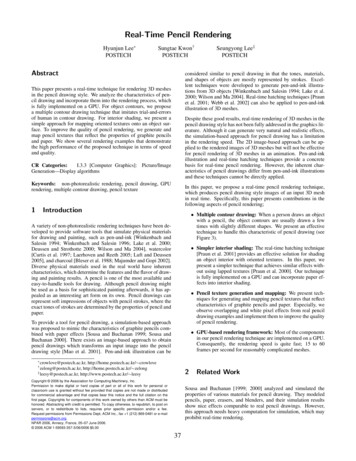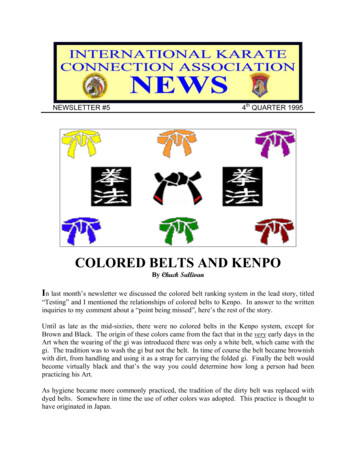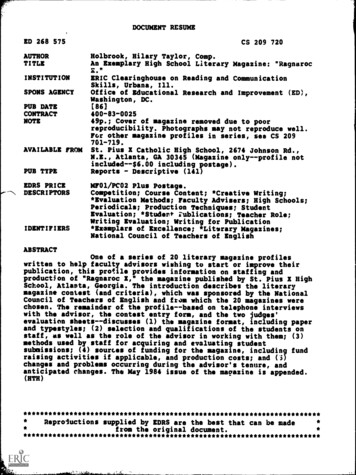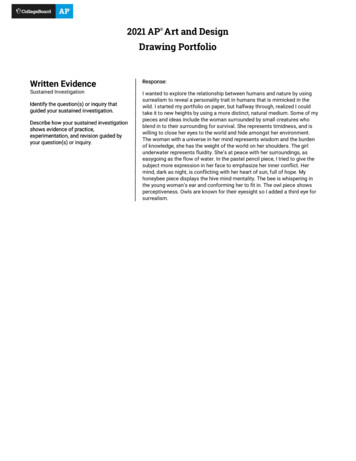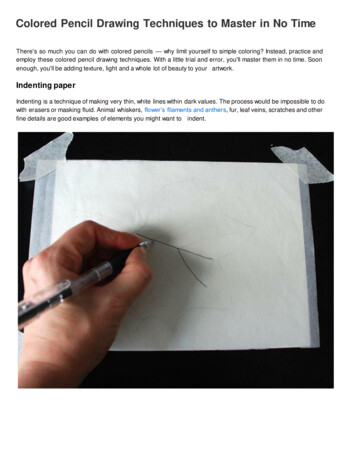
Transcription
Colored Pencil Drawing Techniques to Master in No TimeThere's so much you can do with colored pencils — why limit yourself to simple coloring? Instead, practice andemploy these colored pencil drawing techniques. With a little trial and error, you'll master them in no time. Soonenough, you'll be adding texture, light and a whole lot of beauty to your artwork.Indenting paperIndenting is a technique of making very thin, white lines within dark values. The process would be impossible to dowith erasers or masking fluid. Animal whiskers, flower’s filaments and anthers, fur, leaf veins, scratches and otherfine details are good examples of elements you might want to indent.
How to indent a drawingPlace a piece of transparent paper (tracing paper or wax paper) over your drawing where you want to indent thedrawing. Take a ballpoint pen or a 2H graphite pencil and draw over cat’s whiskers, flower’s filaments, grass blades,house siding or any other areas that you want to indent and texturize. Then, lift the sheet of wax paper and beginshading over the indented area in your drawing. If you place enough color, you’ll soon reveal the strokes youpreviously applied.Drawing highlightsThere are several methods to create the lightest areas in your colored pencil drawings, and they often depend onthe types of paper you draw on.
Drawing highlights on white paperIf you draw on white paper, simply reserve space for the highlights, leaving the paper' s original white tone. Don’tcolor over the white paper with your white colored pencil — the highlights would lose their brilliance. Instead, outlinethe lightest areas with a very light colored pencil like cream or light peach (whatever works best with your drawing)so you don't shade over the white areas by accident. If you outline the lights with a graphite pencil instead, this lineintensifies shaded over it with light colors, flattening out the s p a c e .
Drawing highlights on toned paperIf you draw on toned paper, you can use the white colored pencil to shade the highlights. However, because white isa cool color and often times the highlights are warm and have their own color, shade with a light colored pencil first(cream, light peach, cloud blue, etc.) and then finish up shading with white. Apply a very heavy pencil pressure toachieve the necessary brightness.Highlighting toolsIf the highlights are super tiny or need a punch, try using touch of white crayon, pastel, gouache or even acrylicpaint with a 00 brush. Water dilutes all three mediums, and a quick brush clean -up is a must for acrylic paintbecause it dries instantly. A white Faber-Castell Pitt artist pen can also work great for some drawings.A few artists use an art X-Acto knife to put just a few tiny highlights. Beware: This technique requires practice and isusually done at the very end.Learn more colored pencil drawing t e c h n i q u e s !
RubbingsIn the image below, you see some examples of the textures done as rubbings over sea shells, a cheese grater, atextured box, filigree earrings, a frame, and even a sushi roller. To achieve this look, place your drawing paper overa textured surface like lace, leaves or anything else with bumps and ridges. Rub your colored pencil over the paperand textured surface. Note that rubbings done over thicker drawing paper will be less effective than a thinner paper.Combining mediumsMany artists use watercolor pencils to under-paint large areas such as backgrounds. Use a brush to apply a smallamount of water over the watercolor pencils to dissolve and blend the pigment. Once the paper is dry, coloredpencils can be layered over it.
Some artists combine the Faber-Castell Pitt artist pens and colored pencils to under-paint large areas or to createdetails. Pitt pens come in a wide variety of colors and nibs: extra super -fine, super-fine, fine, medium, etc.
drawing. Take a ballpoint pen or a 2H graphite pencil and draw over cat’s whiskers, flower’s filaments, grass blades, house siding or any other areas that you want to indent and texturize. Then, lift the sheet of wax paper and begin shading over the indented area in your drawing. If y



